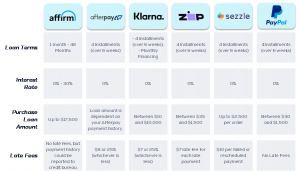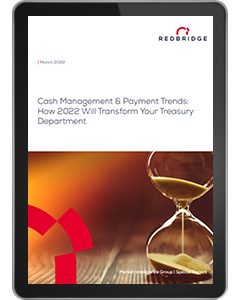“Buy Now, Pay Later”, or BNPL, is not a new concept, but it has gained more popularity now than ever before. Gabriel Lucas and Hector Galvan, from Redbridge, discuss the benefits, the drawbacks and the future of deferred payments from a retailer’s perspective.
What is ‘Buy now, pay later’?
BNPL is a service offered by various companies that allow consumers to online shop and divide purchases into multiple equal payment options.
Typically, the first installment is due at purchase, but most BNPL providers allow customers to pay in a weekly, bi-weekly, or monthly installment. This allows consumers to receive their purchase right away, while giving a flexible alternative to credit cards.
In the U.S. and across the globe, companies like Klarna, Sezzle, and Afterpay have dominated the BNPL landscape partnering up with large scale retailers like Walmart, Target, and Amazon to offer their services.
Key players in the BNPL field
Recently flooded with new players, only a few major players have dominated in the past year. These include: Afterpay, Affirm, Klarna, Zip (previously QuadPay), Sezzle, and now PayPal’s ‘Pay in 4’.

What are the benefits of retailers offering BNPL services?
Not only does BNPL offer consumers the benefit of financial flexibility and increasing purchasing power while making purchases online, but retailers offering this service have also seen significant benefits this past year. As Forbes notes, an estimated $99.4 billion in retail purchases will be made by consumers using BNPL programs in 2021, this is up from $24 billion made in 2020.
Many retailers currently offering BNPL payment options see similar benefits at the end of the day:
1. Lowering cart abandonment and sticker shock
Sticker shock is one of the main reasons consumers abandon their carts. The reality is, for large-ticket items in particular, many consumers simply cannot afford to spend a large sum of money in one transaction. This is where BNPL options provide some relief for consumers.
2. Increase sales and average order value
Retailers know the impact of abandoned carts have on the overall bottom line. This is why it is important to take measures to limit the number of abandoned carts in order to convert these customers.
Businesses who offer and prominently message alternative payment methods, like BNPL, to consumers see the immediate benefit: the BORN Group notes an increase in average order value of more than 30%, meaning that installment payments encourage larger basket sizes and higher-priced sales.
3. Building a larger consumer base
By providing additional, more flexible payment options, retailers – and truly any merchant – have the ability to expand their consumer base to a wider range of demographics. A BNPL option might attract customers who were previously hesitant to buy products because the price was out of their budget.
4. All while still receiving the Full upfront payment
With third-party BNPL providers, businesses don’t have to be wary of the potential risks of managing fraud cases, non-payment, or other related issues. BNPL providers will manage the automated billing, repayment, and fraud cases.
Why BNPL might not be the best solution for all retailers and consumers?
Although offering BNPL solutions can offer a variety of benefits for retailers and consumers, the merchants themselves pay the price for this consumer-friendly financing alternative. Buy Now Pay Later firms charge retailers significantly more than traditional card acceptance.
BNPL players charge consumers’ cards, or bank accounts, themselves, rather than the retailer, and pass on the cost as part of a bundled fee to retailers for different services provided.
According to Tom Richardson, of Financial Review, a typical Visa processing fee in the US is 3%, he says. A BNPL provider, like Sezzle for example, charges retailers fees around 6% plus 30 cents per transaction, with the pitch that this includes the 3% card fee. In most cases though, a 3% processing fee may be well above the actual cost of acquisition. The rate that BNPL companies charge retailers depend on different factors:
- Type of product or service
- Length of time the store has been in business
- What item is purchased
On the consumer end, BNPL can prove to become a slippery slope for a segment of users. BNPL services are often criticized for encouraging consumers to take on debt they might not be able afford.
In addition to these concerns, the BNPL payment option does come at a hefty price. One downside can be from missing scheduled payments that can result in late fees of up to 25% of the past-due amount, depending on the provider you use. Consumers may also mistake that the merchant assess the late fees, potentially damaging their reputation.
Additionally, if you don’t repay the balance amount in due time, you can be reported to the credit bureaus as delinquent.
Regulatory issues
The staggering growth of the Buy Now Pay Later industry is expected to attract the attention of financial regulators. Right now, “buy now, pay later” is not regulated in the way that credit cards are.
In the U.S., BNPL services are covered under the Dodd-Frank Act, which are enforced by the Consumer Financial Protection Bureau, but the federal “Truth in Lending Act” doesn’t apply to many BNPL provider services offered because it only covers credit products that involve at least five payments. This is why the ‘Pay in 4’ model has become so popular across most of the BNPL providers. That means there are no standards for disclosures on fees, amounts owed, credit reporting and payments.
California’s regulators are among the few U.S. watchdogs that have taken substantive actions against the services. Even though most “pay-in-four” products are exempt from those federal rules, California has classified some pay-later products as loans.
The future for BNPL
With COVID-19, there has been a shift in retail shopping and created a new normal. More and more consumers are more apt to making purchases online. According to IBIS World, industry revenue is forecasted to grow at an annualized 9.8% over five years through 2024-25, to $1.1 billion.
This industry expansion and growth has led other non-BNPL specialized fin-tech companies and providers, like PayPay, to offer similar ‘Pay in 4’ services. As a payment gateway service that most merchants already offer, PayPal clearly has, despite its late entrance into the game, a natural advantage.
In late September, Mastercard announced their first step towards offering a BNPL program in the U.S., Australia, and the UK. Their program announced is called “Mastercard Installments,” which allows Mastercard to act as a middle man by enabling banks and fintechs to utilize this installment program to offer loans directly.
Citibank, American Express, JPMorgan Chase, and Goldman Sachs (in partnership with Apple) have also announced future plans to offer ‘post-transaction’ financing options at much more affordable fees.
As we continue to see the growth of BNPL in the retail industry, we will see the expansion of major players in the merchant card and banking industry make a late but large wave in this future trend.
Hector Galvan & Gabriel Lucas
A special report on the cash management & payment trends that will transform your treasury department in 2022
The growth and vitality of the payments industry has fascinated all observers during the past two years of the pandemic. Now with recent geopolitical developments arising from the Russia-Ukraine conflict, it is being tested again.
Our new publication analyzes the most prevalent trends and innovations in the treasury world today.
Included in this publication:
- The Global Resurgence of QR Codes
- Choosing the Right Payment Terminal in an Ever-Changing Environment
- The Rise of Buy Now, Pay Later
- PCI Compliance in an E-Commerce World
- Where Do Banks Stand in the Race for Digital?
- Virtual Accounts, Which Companies Should Implement Them?
- The Future & Alternatives to SWIFT GPI
- Global Digitization in the Depository Space
- “Switching Banks Was the Right Decision”: An Interview with Olivier Bouillaud from Albéa

Download the full publication
